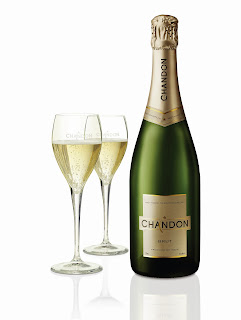 |
| Moet Hennessy's Regional Managing Director Mark Bedingham with a bottle of the Chandon Brut at the launch of the sparkler at the Four Seasons Mumbai on October 20. |
I HAVE just come back to my 18th-floor
room at the Four Seasons Mumbai from a sneak preview tasting of the Chandon Brut and Rose, Moet Hennessy India’s debut methode
traditionelle sparkling wines from Nashik,
convinced that the country has a future as a serious producer of bubbles made
with wine grapes and not Thompson seedless.
The balance was stunning and I felt
honoured to be drinking the sparkler with its maker, Kelly Healy, a New Zealander who has been making sparkling wine for
the past 17 years. It is just the kind of bubbly I would serve friends before a
lazy, conversation-laden Sunday lunch, where I would order in Mini Mughal’s smoky,
juicy butter chicken, and open the Rose (Maharashtra MRP: Rs 1,400) when people
settle down to eat.
This is the first genuine Rose sparkling
wine I have had in India — its competitors, I am afraid, taste like turpentine.
It seamlessly marries the fruitiness of Shiraz with the structure of Pinot Noir
to titillate your palate and draw out best feelings. This is just the sparkling
wine you’d have with wholesome (but not chilli hot) rarha mutton or even the kosha
mangsho of the Bengalis. Dal Makhni and Shahi Paneer are the vegetarian
dishes that I can see getting along famously with the bubbly.
As we tasting the sparklers, I asked Mark Bedingham, Regional Managing Director,
Moet & Hennessy Asia-Pacific about the difference Chandon will make to the
wine drinking culture in the country. For those who can’t afford the price
points of champagne, Bedingham said, Chandon offers “affordable luxury”. He
said the sparklers had been made to “reach out to a whole bunch of new
customers”, especially “the rising young professional class”.
Its custodians expect it to open up
the market, at present very limited for sparkling wine, which have a 3-5 per
cent market share in the country — naturally, because champagne has never been
seriously appreciated; it has either been flaunted or reserved for consumption
on festive occasions. “Emerging lifestyles in India are sympathetic to the
consumption of sparkling wines,” Bedingham said.
The Chandon sparkling wines are now
being produced and bottled at the Nashik-based York Winery, but Moet Hennessy India is all set to open its own
winery at Dindori, a taluka with
perfect soil for wine grapes that was first put on the country’s wine map by Rajeev Samant, the man behind the
humongous success of Sula Vineyards.
“We are here to be the pioneers for the highest quality of Indian wines,”
Bedingham assured me as I couldn’t stop admiring the Rose. The tasting session
convinced me that he wasn’t overstating his company’s case.
A SPARKLING NIGHT: The Chandon sparklers were launched on October 19 at a glittering party with the chatterati in full attendance, who, in true Mumbai style, sashayed in only after midnight. From the glamorous writer Shobhaa De, who looked younger than her daughter, to industrialist Gautam Singhania and actor Arjun Rampal, the city’s A-List partied hard till the wee hours to the heart-pumping music of the deejay, who had been flown in for the day from Paris.
A SPARKLING NIGHT: The Chandon sparklers were launched on October 19 at a glittering party with the chatterati in full attendance, who, in true Mumbai style, sashayed in only after midnight. From the glamorous writer Shobhaa De, who looked younger than her daughter, to industrialist Gautam Singhania and actor Arjun Rampal, the city’s A-List partied hard till the wee hours to the heart-pumping music of the deejay, who had been flown in for the day from Paris.
The wine world was there too — from Rajeev Samant, who was a force to reckon with on the dance floor,
and Ashwin Deo, a former managing
director of Moet Hennessy India who has now his own wine label, Turning Point, to
Sonal Holland of ITC Hotels, who, I
learnt, is one of four Indians to get the WSET-IV certificate, which is quite a
creditable achievement, to Indian Wine Academy President Subhash Arora, Sommelier India
founder-editor Reva Singh, Business Standard columnist Alok Chandra, and celebrated wine
trainer and writer Magandeep Singh.
I was most happy to meet Ian
Morden, the estate director of Cloudy Bay, a jewel in the Moet Hennessy
crown. A South African whose warmth is so natural and welcoming, Morden was the
one who was given the charge of initiating the Chandon project five years ago.
He still remembers how his first port of call was Sula, where Samant floored
him with his hospitality. Maybe that gave Moet Hennessy the confidence to
launch Chandon.

No comments:
Post a Comment